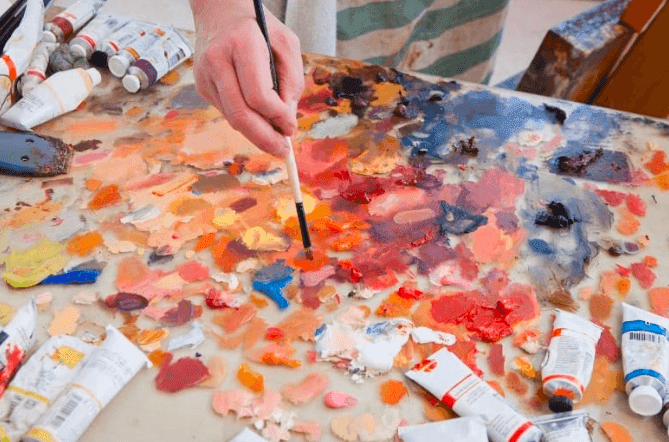The beauty of a home is manifested in the arts of your walls. The joy of life is reflected through the presence of bright colors too. While trying to acquire the best oil paints during the creative process, there are myths and misconceptions that you might have heard about oil paints. One of them is how long it takes an oil painting to dry.
So, how long do oil paintings take to dry? On average, it takes up to 24 hours for an oil painting to dry. Factors such as the color of the paint, thickness of layers applied, the medium used, the surface it is applied on, the room’s temperature, etc., will affect the drying period.
Of course, it is a very frustrating experience, and you will need to find the appropriate ways to deal with it. It is vital to understand everything that you choose to work with as this prevents the occurrence of unpleasant results. This article will discuss the duration oil paintings take to dry and give you tips on how to speed up the drying process.
How Long Does Oil Paintings Take to Dry?
Sometimes there is no definite answer to this question. We’ve heard people come with different experiences. Some Oils paint takes up to a year to dry entirely; however, most will take approximately 24 hours. Others take up to a week or even a few months to dry to touch. This variation of drying time is caused by several factors as outlined below:
- Color spectrum
Oil-based paints come in different color pigments, just like acrylics and watercolors. This is one factor contributing to the different lengths of time an oil painting will take to dry. When a percentage of a given paint pigment is denser than others, this results in more extended drying periods. It will take 24 hours to dry if you avoid over-saturating it by applying it to a certain level of viscosity. Like any other oil-based paint, there are specific color shades containing iron oxide like the orange, red, and brown shades that dry quickly.
- Environment
The nature of the environment is a critical measure when using this type of paint medium. Factors such as temperature, humidity levels, dust particles, and direct sunlight affect the painting process. Such paints work effectively under cold conditions with better results than under hot conditions. Despite the excellent factor, such humid conditions can make the painting not dry very fast.
- Nature of the surface
The degree of the surface to absorb the paint also affects the drying times. Painting on a non-absorbent surface takes a lot more time than absorbent surfaces. For example, when painting a block of wood and a piece of paper. Primered wood will take longer to dry because it is a non-absorbent surface, while paper will take a shorter time to dry because it will suck oil from the paint area.
- The thickness of the layers
It is basic knowledge that a thin layer of paint will dry faster than a thick layer.
- The medium type
The drying oil mixed with paint as binders also influences the period of paint drying. Oil such as sunflower oil, poppy oil, or walnut oil takes twice the time linseed takes to dry the paint, approximately two days. Here the linseed is the most recommended binding agent for your painting.
- Techniques used
This is another way that influences the drying time. The fresco and the impasto techniques take more time to completely dry due to the presence of layers that will need to dry up before proceeding to the next layer.
How to Make Oil Paint Dry Faster
Here is brief information on how the Alkyd mediums and solvents and non-solvents speed up the drying times:
- Use the linseed together with your oil-based paint; this medium speeds up the paint's drying process compared to the rest of the other oils.
- The alkyd mediums contain a resin that speeds up the drying time.
- The solvents go along with the thinners as chemicals to dry the oil paints faster by forming a thin layer of oil paint.
Apart from using the solvents and the mediums to speed up the drying times, below are tips you can perform on your own to elevate the drying times.
- Store your remaining paint in a well-ventilated room with an adequate supply of light. This will achieve unrestricted airflow, and the paint will dry quickly. Here are the several ways you can store oil painting discussed by paintcentric.
- Apply a gesso or primer on your canvas before you start painting. It gives the uncoated canvas a porous coating for easy adherence to your oil painting on the surface.
- Consider the color palette to use. Here, consider only the paints with mineral pigments. The iron, as mentioned above, oxide paints dry faster.
- If you want to beat the deadline, you can use external heat to fasten the drying process of your oil paints. However, it would be best if you were extra careful to prevent cracks in the paint. Hold the heat source at an arm's-length distance from the paint surface within 54 degrees Celsius.
- Varnish your painting after a period of half a year.
- Use a base coat such as acrylics before your oil-based paint. The base coat is better to use as it dries more quickly than oils; now, you can use it for the next layer before adding the texture and color paint.
- Apply finer layers of paint - The layers should be thinner to avoid a soggy painting when you touch it after a long time.
After some time you might be tempted to confirm if your paintwork is completely dry or not. Check it after a day or during your desired time by scratching over a small area that is not visible from far. If you see some powder coming out, this means that your work is ready for use.
Frequently Asked Questions
Here are some of the most frequently asked question regarding oil-based paintings:
- How do you make oil paintings dry faster?
You can speed up the drying process of an oil painting by carefully exposing it to heat. The higher the heat, the shorter time it takes to dry. Cooler air slows down the drying process.
- Is it better to paint with oil or acrylic?
Acrylic paint is far much better than oil paint. While oil paints take longer to dry, acrylic can dry in just a few hours. Acrylics are also more durable and offer vibrant colors.
- How do you store oil paintings when drying?
New painting is vulnerable to scratches, dust, water, fingerprints, and weather elements. You need to store your oil painting in a safe place to prevent damage as it dries. Here are several ways you can store oil from paint centric: drying racks, flat file cabinets, wooden racks and shelves, wooden crates and mirror boxes, etc.
Conclusion
Knowing how long oil paintings take to dry, making them dry faster, and correctly storing them when drying are crucial things every paint artist should know. Oil-based paints are intrinsically slow in drying; they can take a whole day or more depending on a few factors discussed in this text. If you have been reading this article, we hope you understand the factors affecting the oil paint drying process.
We all know paints such as acrylic can do a better job than oil paints and have more advantages. However, if you are an oil-based paint die-hard fan, we hope you found this article informative, and it will help you maximize the fun part of using these oil-based paints to color your worlds.
















.jpg)



.jpg)




0 Comments